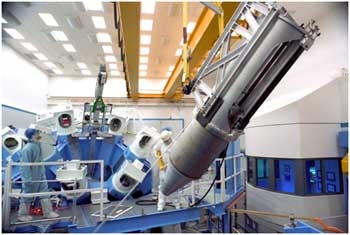LLNL helps open a new era of plasma nuclear science
 (Download Image)
Instrument used to measure scattered nuclei is pictured during installation at the Omega Laser Facility. The blue chamber where sixty intense lasers converge to create high-energy density plasma conditions can be seen in the background.
(Download Image)
Instrument used to measure scattered nuclei is pictured during installation at the Omega Laser Facility. The blue chamber where sixty intense lasers converge to create high-energy density plasma conditions can be seen in the background.
In a unique experiment recently published in Physical Review Letters , researchers used the Omega Laser Facility at the University of Rochester to make precise measurements of a fundamental nuclear process -- the elastic scattering of neutrons off heavy forms of hydrogen.
This is the first time a fundamental nuclear physics experiment has been achieved using a high-energy-density laser facility. Researchers from Lawrence Livermore National Laboratory, the Massachusetts Institute of Technology's Plasma Science and Fusion Center, and the Laboratory for Laser Energetics at the Unniversity of Rochester collaborated on the project.
The Omega Laser Facility has given rise to many innovative ways to probe matter under conditions of extreme energy density. These conditions include pressures of 100 billion atmospheres, temperatures of 200 million kelvins and densities 20 times that of gold; they occur in nature only at the center of giant planets such as Jupiter and Saturn, as well as inside stars.
Researchers typically probe nuclear reactions using conventional accelerators. In the new work, the research team created a hot, dense plasma, in which electrons are stripped off of their parent atoms to create an interpenetrating gas, or "soup," of positive and negative charges. The plasma state comprises stars, fluorescent lights, lightning, and, in fact, 99 percent of the visible universe. It is often referred to as the fourth state of matter, after solids, liquids and gases.
To achieve this plasma state on the Omega laser, all 60 of its powerful laser beams strike the outer surface of a glass capsule one millimeter in diameter filled with heavy isotopes of hydrogen -- deuterium (D) and tritium (T). The laser beams generate a rapidly expanding high-temperature plasma gas on the surface of the capsule, causing the capsule to implode. This implosion, in turn, creates an extremely hot (100 million degrees Kelvin) plasma of D and T ions and electrons inside the capsule. A small fraction of D and T ions fuse together, a process that generates a neutron travelling at one-sixth the speed of light with about 14.1 million electron volts of energy. (In contrast, an ordinary chemical reaction - such as the burning of wood or coal - generates about one electron volt of energy.).
As these energetic neutrons race out of the imploding capsule, a small fraction collides and scatters, like billiard balls, off the surrounding D and T ions. From these rare collisions, and from the corresponding transfer of energy from the neutrons to these D and T ions, the researchers were able to obtain an accurate measurement of the nuclear collision process.
Accelerator-based measurements are used to normalize the absolute cross-section. Once normalized, the shape of the low-energy cross section is obtained with more accuracy than possible with accelerators. More importantly, the experimental results match theoretical calculations, providing not only a boost to nuclear theory but also data on reactions of crucial importance to nuclear astrophysics and fusion energy research.
The researchers believe that important variations of the technique in the promising plasma environment will soon emerge, leading to innovative measurements into other fundamental nuclear processes. One such experiment is the fusion of helium, which is important because it is the dominant energy-producing step by which the sun generates its vast energy, illustrating that solar power is in fact fusion power.
"With this class of experiments imminent, a new and exciting field of research is ushered in: plasma nuclear science, blending the disciplines of plasma and nuclear physics," said lead researcher Johan Frenje of MIT.
The Livermore team includes Dennis McNabb, Petr Navratil and Sofia Quaglioni.
This research was supported by the National Nuclear Security Administration, an agency within the Department of Energy. NNSA funds the operation of the Omega Laser Facility and the National Laser Users' Facility (NLUF) through which this research was carried out, as well as operations at LLNL. NLUF allows university researchers' access to the Omega Laser Facility to perform basic high energy density physics experiments. This research also was partly funded by the DOE's Office of Fusion Energy Science through the University of Rochester's Fusion Science Center and the Laboratory Directed Research and Development program at LLNL. The DOE Offices of Nuclear Physics and Advanced Scientific Computing Research supported the development of the groundbreaking nuclear theory techniques used to perform the calculations presented in this work.
The research appears in the Sept. 16 edition of Physical Review Letters .
Contact
Anne M Stark[email protected]
925-422-9799
Related Links
Measurements of the Differential Cross Sections for the Elastic n-3H and n-2H Scattering at 14.1 MeV by Using an Inertial Confinement Fusion FacilityHow ICF Works
Researchers measure field strength and density of ICF implosions
Laboratory of Laser Energetics
Massachusetts Institute of Technology
Tags
Lasers and Optical S&TLasers
National Ignition Facility and Photon Science
Physical and Life Sciences
Science
Featured Articles







